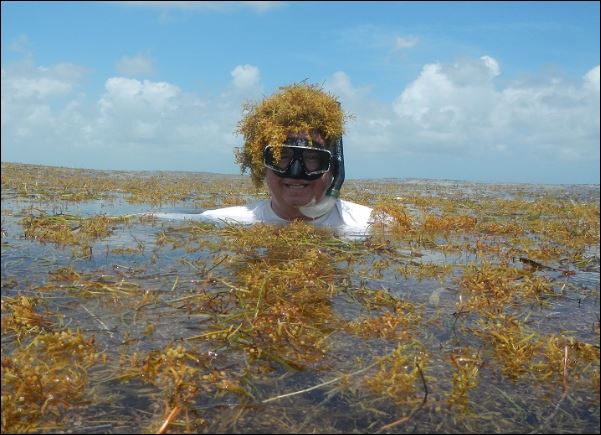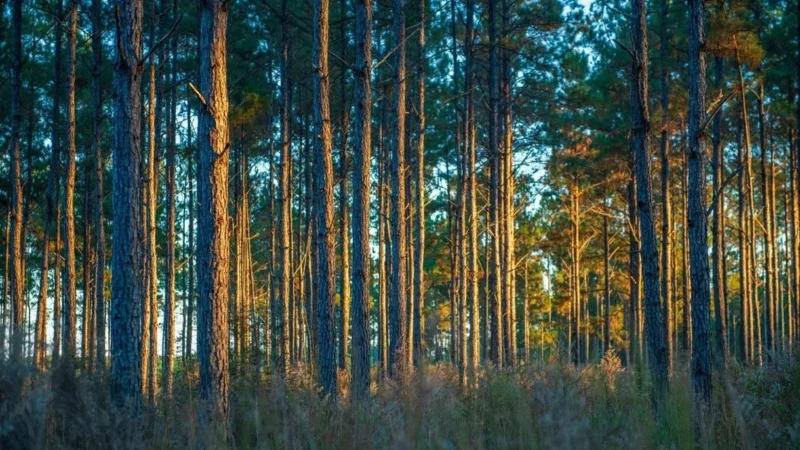Keeping Florida’s shoreline beautiful has long resulted in interesting piles of trash with, inevitability, a kitchen sink found somewhere among the mangroves.
Now there is a menace that buries everything else, yet needs to be cleaned up all the same: Deep piles of sargassum, a yellow-brown seaweed normally stuck out in the tropical Atlantic Ocean, are finding a way to foul many Southeast Florida beaches and Caribbean islands.
Tourism types are terrified.
Marshall Washington runs the Ron Jon Surf shop in Key West, just blocks from a beach where the stinky seaweed beached itself last year.
“It sucked. It was terrible. It was terrible,” he said. “There were times when it was really bad. Piles of about at least a foot and a half. The main beaches were hit pretty hard; certain days there were, pretty much, like nobody going to them.”
Researchers predict the return of sargassum to the eastern side of the Florida Keys later this month or in May. Washington is not happy.
“Last year was just not cool. Not cool at all,” he said. “I’m not looking forward to this year.”
‘Great sargassum belt’
Millions of tons of yellow-brown algae have been swirling about in a region of the tropical Atlantic known as the Sargasso Sea. With no land in sight, ocean currents have been making the sargassum do figure-eights for centuries, the massive mats of algae suspended at the surface by its own air bladders.
In 2011, a massive amount of sargassum broke free and headed west. Scientists are not in agreement as to why
Modern-day credit for discovering the huge wayward mats of sargassum goes to satellites, which first detected the mats breaking free from centuries of doing donuts through the waves in their Atlantic Ocean parking lot.
The Great Atlantic Sargassum Belt was coined by scientists about the same time that oceanographer Ajit Subramaniam, who has run scientific research expeditions in the South Atlantic for 25 years, is credited for first coming across the endless blotches of sargassum in 2018 during one of his expeditions.
It has been growing at such a rate as to alarm scientists. Two years ago, the Great Atlantic Sargassum Belt grew to a combined 24.2 million tons — about four times the weight of the Great Pyramid of Giza — and it was recognized as the largest macroalgae bloom in the world.
After the sargassum died back that winter, it regrew in 2023 to a swath that stretched some 5,000 miles long and 300 miles wide, extending from West Africa to the Gulf of Mexico and weighed in at some 13 million tons.
The Optical Oceanography Laboratory at USF’s College of Marine Science tracks the sargassum under a $3 million grant it shares to use satellites to better predict where the massive mats will come ashore throughout the Caribbean and Gulf of Mexico.
USF’s Sargassum Watch reports the belt has regrown this summer to 9 million tons so far, and it is expected to continue to grow to near-record levels by the fall.
That doesn’t mean you have to cancel your vacation to Barbados.
“One thing to know about the Great Atlantic Sargassum Belt is not just one contiguous mass that’s going to come and swallow the entire Caribbean and Florida,” said USF’s Brian Barnes, a lead sargassum researcher.
But it can bury your favorite beach. To get a heads up, Barnes is working on a tracking system that uses satellites in ways that can better predict where it is headed.
“We can identify the sargassum and know where the water is moving and thus where the sargassum will be moving and make some predictions on which beaches will be impacted.”
‘Very nice ecosystem’
Each floating mass of sargassum is its own remarkably beneficial ecosystem.
Sargassum mats provide food, refuge, and breeding grounds for fish, sea turtles, marine birds, crabs, and shrimp. The seaweed is packed with nutrition, belches oxygen, and sucks up enough carbon that it is notable in the fight against global warming.
The sargassum fish has adapted to look like its floating protector. The strange-looking flat fish with lots of fins knows of no other existence than within the nooks and crannies of the sargassum mat where it lives its entire life. It ambushes its prey, eats its own, and when being preyed upon leaps up out of the water and comes to rest atop the mass of seaweed, where it can live for far longer than its underwater stalker retains interest.
Scientists have discovered 110 animals that favor life within the seaweed including ten endemic species that live nowhere else on Earth. Sargassum’s wealth of riches draws game fish, creating a commercial fishery worth $100 million a year.
Barry Rosen, a seaweed expert at Florida Gulf Coast University in Fort Myers, calls the sargassum migration a normal, healthy environmental fact of ocean life.
“It is a mass of living organisms pumping oxygen into the air,” he said. “It’s a very nice ecosystem, and it typically doesn’t cause a problem.”
Until it does. And that is when it hits land.
‘A devastating mainstay’
The Mexican federal government is building four sargassum-collecting vessels costing around $783,500 each it hopes will work to help protect its Caribbean coast from sargassum.
Hotels between Cancun and Puerto Morelos reported spending around $200,000 each on wages for beach clean-up personnel and transporting seaweed to disposal sites after the 2018 sargassum surge
Midsized hotels with large beachfronts are estimated to be spending thousands of dollars a day on removal, if not more, during peak moments
Records show the cleanup costs for sargassum were about $3.5 million in the greater Miami-Dade County area in 2019 and $120 million in the Caribbean in 2018.
The city of Key West spends about $1 million annually on sargassum cleanup, with more in reserve just in case. Even though the beaches are tiny in Key West, tourists rule.
Miami-Dade County, which spent more than $3.9 million on sargassum cleanup last year, has requested an additional $2 million from the state for upcoming cleanup efforts.
While USF and others are using grant money to determine where sargassum will go, Florida Atlantic University’s Harbor Branch Oceanographic Institute has received a $1.3 million grant from the Florida Department of Emergency Management to assess how to best dispose of the seaweeds once it has arrived.
Problems abound when sargassum isn’t cleaned up right away, not the least of which is the hydrogen sulfide it emits.
“Sargassum is becoming a devastating mainstay in parts of Florida’s coastal communities, particularly in the Florida Keys, where massive blooms continue to recur,” Brian Lapointe, algae bloom expert at FAU, told the university’s magazine. “Economically, a ‘severe’ sargassum event could have more than a $20 million impact in just the Keys alone.”
9(MDEwNzczMDA2MDEzNTg3ODA1MTAzZjYxNg004))






